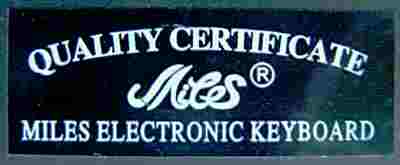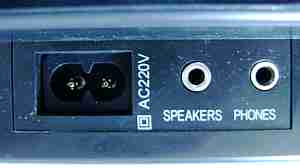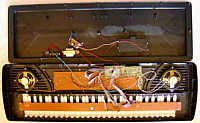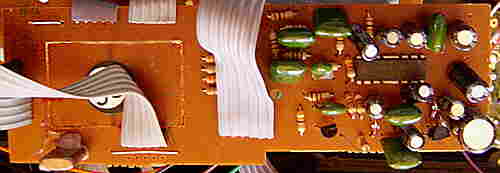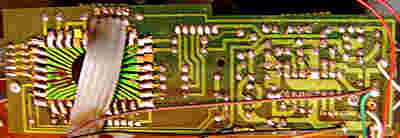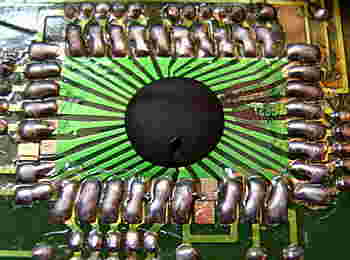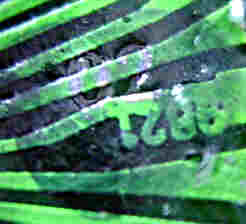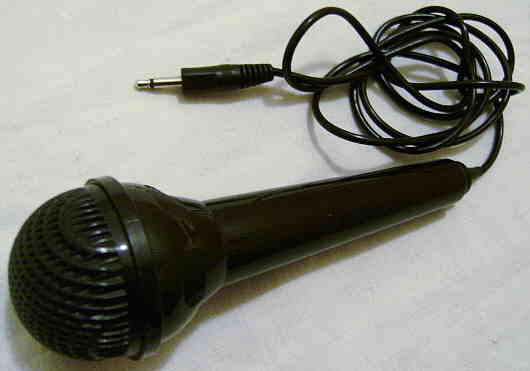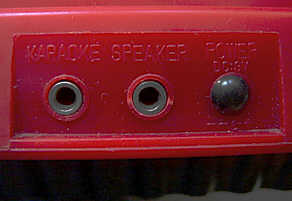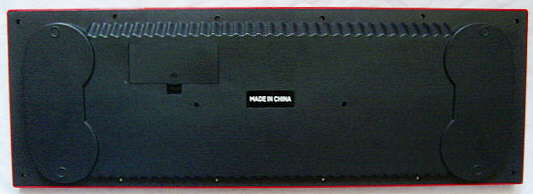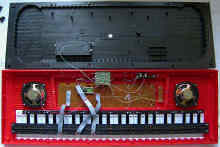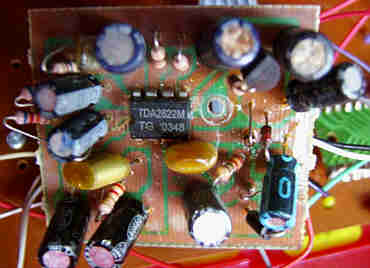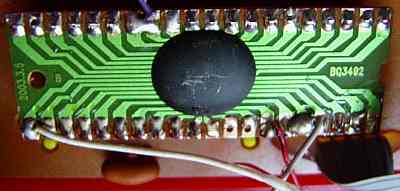 |

lo-fi keyboard with cold digital sound, programmable rhythm & cheesy
accompaniment |
|
|
|
|
Toy Quest
- Groovy Beat
Miles MLS-4900A
This midsize tablehooter employs a modified My
Music Center sound engine and was likely a direct predecessor of
the great Yongmei YM-2100. Unlike
the latter it has only 10 preset sounds and rhythms, less polyphony and
the cold digital sound is much noisier and a bit harsher. But it still
has the programmable rhythm and switchable chord and bass timbres. Like
with other Yongmei tablehooters, when new it stank badly of acrid
chemicals and makes some polyphony flaws by omitted key matrix diodes.
The digital waveforms here sound much noisier than with the YM-2100, and
the 8 drumpad buttons here have no animal voices but include 2 synth toms.
The chord voice and the bass of the accompaniments can be switched among
each 3 preset sounds and there is a nicely archaic sounding fingered chord
mode that accepts beside establishment chords also wild disharmonic note
combinations. The low resolution sample percussion sounds thin and hissy,
but with the distorted synth toms and the archaic accompaniment they sound
nicely cheesy. Annoying is that even at the lowest volume setting the keyboard
still yells way too loud, and there is also some mains hum. Despite stereo
sound the speakers jack is only mono.
The instruction manual is full of gibberish Engrish misspellings and
contains partly wrong information. E.g. in claims there would be the features:
"Chord/ Tremolo/ Portamento/ Infix/ Bass effect" although there is definitely
neither portamento (glide tones) nor tremolo, and the meaning of "Infix"
makes also no sense. Perhaps they meant with "Infix / Bass effect" on the
box simply that during accompaniment the bass can only sound between chord
notes instead of simultaneously to save polyphony, but in the manual is
in the section "Automatic bass chord:" the confusing instruction: "C, when
chord being played, press chord key or bass key to change the timbre, press
infix key to improve timbre, or press normal key to cancel." Bizarre is
that the 2 jacks on the back are labelled "speakers" and "phones" despite
according to the manual the "phones" one should be a microphone jack. Like
with other Yongmei/ Miles keyboards, also here the manual has schematics
on its back, but unfortunately here the keys and buttons in the keyboard
matrix are not labelled at all, thus it is no help to identify keyboard
matrix eastereggs.

main features:
-
49 midsize keys
-
2 built-in speakers (stereo, sound thin and bassless)
-
main voice polyphony up to 4 notes (only 2 with accompaniment, chorus sounds
halve polyphony | Due to missing key matrix diodes only 2 note polyphonic
play is reliably possible.)
-
10 OBS preset sounds {piano, organ, violin, trumpet, flute, space, string,
guitar, bell, mandolin}
-
10 OBS preset rhythms {rock, march, rhumba, tango, pop, s.rock, waltz,
bossanova, country, disco}
-
volume +/- buttons (8 steps, all are too loud)
-
vibrato & sustain buttons
-
tempo +/- buttons (25 steps)
-
fill-in button
-
8 drumpad buttons {base, snare, close hihat, open hihat, crash cymbal,
cowbell, low synth tom, high synth tom}
-
programmable 32 step rhythm pattern (custom drummer)
-
primitive sequencer (unusable by a bug | monophonic record/ play of 38
notes without rhythm/ accompaniment, no edit)
-
single finger & fingered accompaniment (manual chord mode with rhythm
off)
-
3 chord preset sounds {e-piano, synth string, banjo} (cycled through with
a single button)
-
3 bass preset sounds {e-piano, cello, jazz organ} (cycled through with
a single button)
-
main voice sound is based on 2 layered static waveforms with independent
volume envelopes (attack- decay?, some with mandolin ring). Like with My
Music Center, many employ a detuned cold chorus, but the bass range
here is less disharmonic and the envelopes are more percussive and have
no zipper noise. The waveforms have low resolution and contain much digital
noise especially in the bass range. Percussion is made from low resolution
samples.
-
CPU= "9821(?), 02" (37 pin COB, Holtek HT3492)
-
8 demo melodies (complex orchestrated)
-
battery alarm (steady short beeps)
-
mains & battery operated
-
jacks for mains cable, microphone? (mislabelled "phones"), speakers (only
mono)
modifications:
-
wrong speaker polarity corrected.
notes:
The case of this instrument is a little wacky and inside my specimen one
of the PCB posts was cracked off. Also one speaker was wired with wrong
polarity, but fixing it didn't improve the bass response really much. But
at least the keys here work astonishingly well for a piece of Yongmei/
Miles hardware although the sharps need a tiny bit too much force. The
melody section of the keyboard starts on the 2nd 'g' (labelled '5') instead
of the 2nd 'c' (labelled '1') like the embossed characters above the keys
indicate. The button style resembles much my Sankai
01870K, but the random looking button order on the control panel
is quite illogical. There are also some Engrish misspellings on it and
the drumpads show wrong icons. Interesting is that the photo in my Sankai
01870K manual called that keyboard a "Miles MLS-490B", thus both
likely belong to the same hardware family; also the CPU looks similar.
The volume can be only set between too loud and louder and there is noticeable
static mains hum and at high volume some key matrix beep in the background.
(This may be result of amplifier flaws; also the hissy timbre may be caused
by an oscillating amp IC.) The steady blipping battery alarm is also active
during mains operation, and the buttons for preset sounds, volume, tempo
and rhythm/ sequencer programming play a blip (like from a Pong videogame),
which disturbs live performance. I later identified the CPU "9821" by a
datasheet of 1998-02-09 as Holtek HT3492 "49 Key Multi-Function Instrument",
which is obviously a 6 channel Ad-lib
Micro® - very similar like HT3670 with slightly changed pinout
(more leds etc.). Annoying is that despite the sound generator can play
up to 4 note polyphonic, by the lack of key matrix diodes the keyboard
adds wrong additional notes when more than 2 keys are pressed. (Upgrading
it with 49 diodes is recommended to make this thing fully playable, although
it will take some hours of solder work. I haven't modified mine yet and
haven't analyzed the hardware closer.)
The main voice sound engine is based on My
Music Center and sounds like a hissy lo-fi version of Yongmei
YM-2100 (see there). Unlike the latter, the low resolution waveforms
contain much digital noise (not zipper noise) that makes especially the
bass range sound rough. Preset sounds with chorus halve the polyphony (i.e.
2 instead of 4 notes, or only monophonic play with chord or accompaniment).
Like there, the sounds contain no vibrato. The "piano" reminds to an e-piano
or e-bass. "organ" is a harsh digital wannabe metal pipe organ timbre that
rather reminds to an oboe; "trumpet" is similar. "violin" is fairly ok;
its bass range resembles a saxophone. "flute" sounds like a metal flute
with hissy digital wind noise during attack (caused by fast zipper noise?);
it also reminds to harshly overblown thin metal street organ rank. "space"
is a slowly louder fading dull synth strings timbre with chorus and short
sustain. "string" is brighter with chorus and faster attack; during sustain
it turns duller because the brighter subvoice decays faster. The "guitar"
sounds bright and slightly reminds to a clavinet or banjo. "bell" is the
typical My Music Center sound with chorus and is rather a bright
and cheesy synth harp. The "mandolin" rings with about 8Hz. The vibrato
button adds a 6Hz vibrato and the sustain button 1 second long sustain
to the main voice. Like with Yongmei YM-2100 they neither affect
held notes nor chord or accompaniment.
The percussion is made from low resolution samples those
sound thin and noisy. Especially the synth toms additionally sound distorted,
which makes the "rhumba" and "bossanova" rhythm sound special. The
drumpad buttons show instead of {base, snare, close hihat, open hihat,
crash cymbal, cowbell, low synth tom, high synth tom} wrong icons, those
often have a letter behind them: {base 1, hihat c, hihat, cowbells? h,
snare? s, hihat s, tom h, tom m}. The custom drummer works and behaves
like with Yongmei YM-2100 (see
there, press "noll/ play" to enter a pause step) and like there it can
be combined with the accompaniments of preset rhythms.
The chord voice of manual chord and accompaniment can switched between
3 preset sounds (a button cycles through them). The 1st resembles an e-piano,
the 2nd a decaying synth string timbre with short sustain, the 3rd a bright
and percussive picked string like a banjo. Also the bass voice of the accompaniment
can be switches with a button between 3 preset sounds. The 1st resembles
an e-piano or sonorous guitar, the 2nd a cello or low saxophone and the
3rd resembles a dull and sonorous tooting Hammond organ. Like with YM-2100,
switching the chord preset sound or pressing accompaniment
volume buttons does not affect held chord notes and the automatic accompaniments
employ the same archaic pattern style (monophonic bass + chopped chord
voice). Unfortunately there is no separate rhythm volume control,
but you can program a blank user pattern if you only want the accompaniment.
Switching rhythms re- starts the pattern immediately, but unlike YM-2100,
here fill-in patterns don't mute accompaniment.
A very bizarre bug makes the (anyway primitive) sequencer unusable;
when alternating notes in different octaves are recorded, some of the notes
(typically those of higher octaves) are skipped; but unlike YM-2100 here
they already don't sound during record and not only during playback, and
the sequencer doesn't attempt to record polyphonic notes.

The demo melodies are nice but fairly short and employ a monophonic
main voice with standard accompaniment. I confirmed wrong melody names
from the Holtek HT3492 datasheet.
The 8 demo melodies are:
-
American Patrol
-
Fly MeTo The Moon
-
Ansamo Mockou [= "Besame Mucho"]
-
Capttain Contest [= "Camptown Races", cowboy music]
-
Nightingale [= "Little Brown Jug"]
-
VoiceOf Spring [= "Song of Spring"]
-
Music Box Dancer
-
Serenade [= "Nocturne"?]
With "Fly me to the Moon" the programmer must have been badly mooned too,
because the the main voice notes don't stay in sync to the rhythm at all
(or should that be a jazzy improvisation?). The "Music Box Dancer" plays
lovely cheesy in the bright "bell" timbre but is unfortunately way too
short.
Toy Quest - Groovy Beat
It is red, it has keys and it is not a stage synth by Clavia...
Yes, also this red Chinese midsize tablehooter is a Miles
MLS-4900A variant, but lacks some of its features. By its hardware
construction it looks clearly like a Yongmei/ Miles product,
although the PCB and CPU package strongly differs from the MLS-4900A. There
is no brand name on it, but I saw/ was told on eBay that it was
released as Groovy Beat - Music Studio (apparently by Toy Quest,
model 45457). The CPU number "2003.3.5" may hint that it was made in 2003.

The only 6 plastic drumpads and many control panel buttons bounce badly
due to wacky metal spring contacts, and like the MLS-4900A the keyboard
has polyphony flaws by the lack of key matrix diodes. Also the volume can
not be set lower than high ambient volume.
different main features:
-
only 6 drumpad buttons {base, snare, crash cymbal, cowbell, low synth tom,
high synth tom}
-
only mono sound (despite 2 speakers)
-
CPU= "BQ3492, 2003.3.5, 8" (40 pin DIL-shape COB, Holtek HT3492)
-
no AC-adapter jack
notes:
Also with this Yongmei tablehooter the case plastic is fairly flimsy; my
used specimen had a cracked case bottom. Very odd is that the AC-adapter
jack was simply omitted, despite their is a plugged hole for it at the
case back. The case bottom has the same shape like with Miles
3738.
A different case variant of this hardware was released as High Frequency
- The Composer (49 midsize keys, rounded buttons in blue, yellow, red?).
Likely another variant with case resembling MLS-4900A was the Elegance
4918 (bottom label JC-4918 ?, different button layout, at least
a black and a purple (lilac?) version exist, seen on eBay). Many
other (often much bigger) keyboards were released in the Miles MLS-4900A
hardware class (all seen on eBay). These likely include
Yongmei
YM-490F (case like Sankai 01504H,
54 fullsize keys including leftmost 5 fakes wired to drumpads, 6 drumpads
- also released as Musical Centre Carsan 803 with the fake keys
to the right?) and
Jia Yin JY-520B (54 fullsize keys including leftmost
5 fakes wired to drumpads, grey case with 6 grey round drumpads - also
released as Jia Yin SY-520 ??). Another was named Techno-Beat.
(54 fullsize keys, black with ugly grey panel and mic). I first thought
that also
Sankai SK-4901 (56 midsize keys including 7 fakes wired
to drumpads), big rectangular black case with odd shaped funky coloured
buttons) would be of this hardware class, but I saw on eBay that
it has 10 demos instead of 8 and a different rhythm/ sound set; a fullsize
version of that one was released as Sankai SK-510 (case like Yongmei
YM-490F, but the 5 fake keys are to the right). Someone had e-mailed
me long time ago that another fullsize variant was apparently released
as Kids Musical Fun (includes demo "Fly Me To The Moon", but 8 note
polyphonic??, case shape like the infamous Kamichi
transistor tooter, but in blue with red control panel - also a black and
silver version was made).
| removal
of these screws voids warranty... |
|
|
 |

|
|
| |
back
|
|



